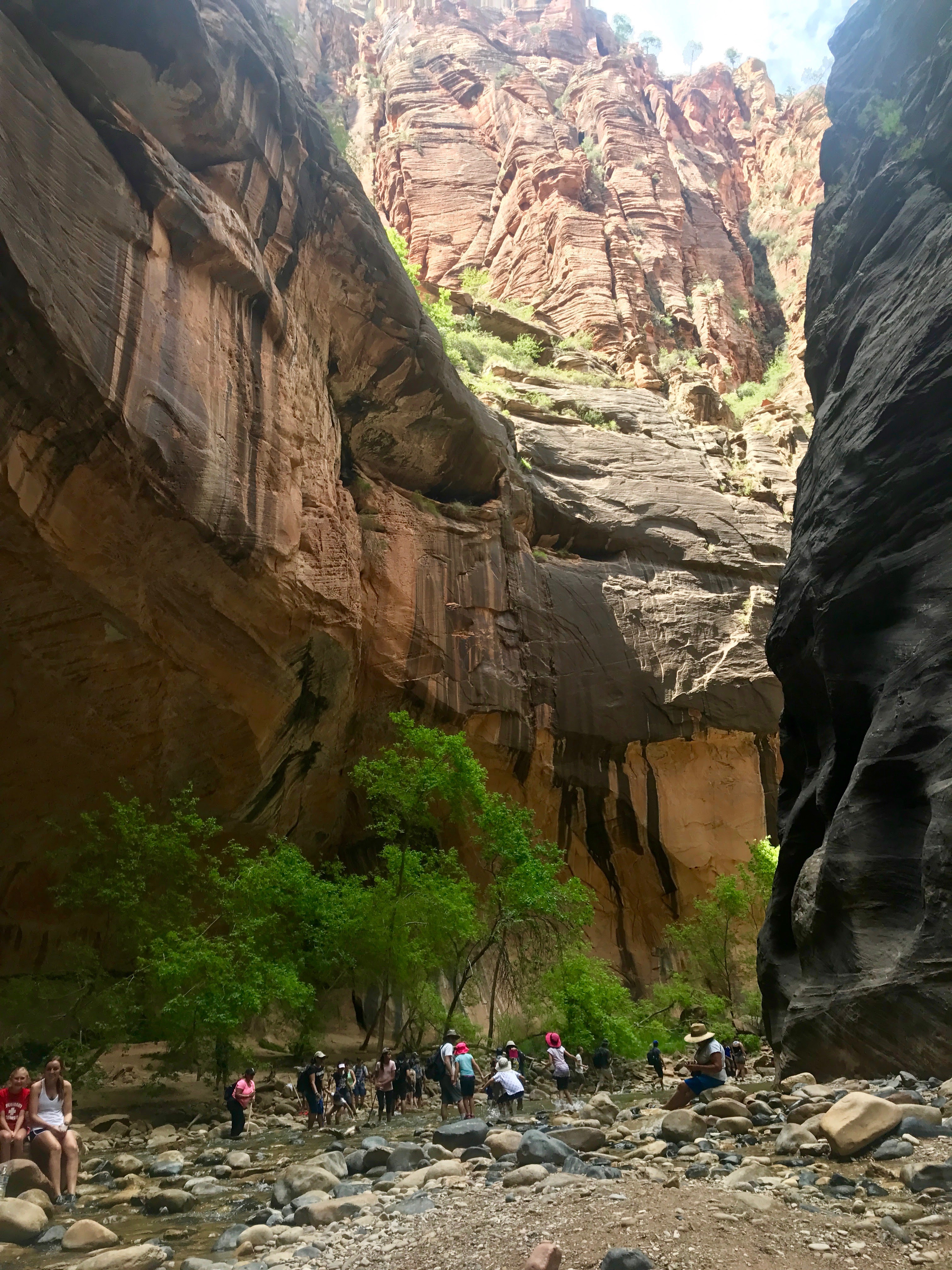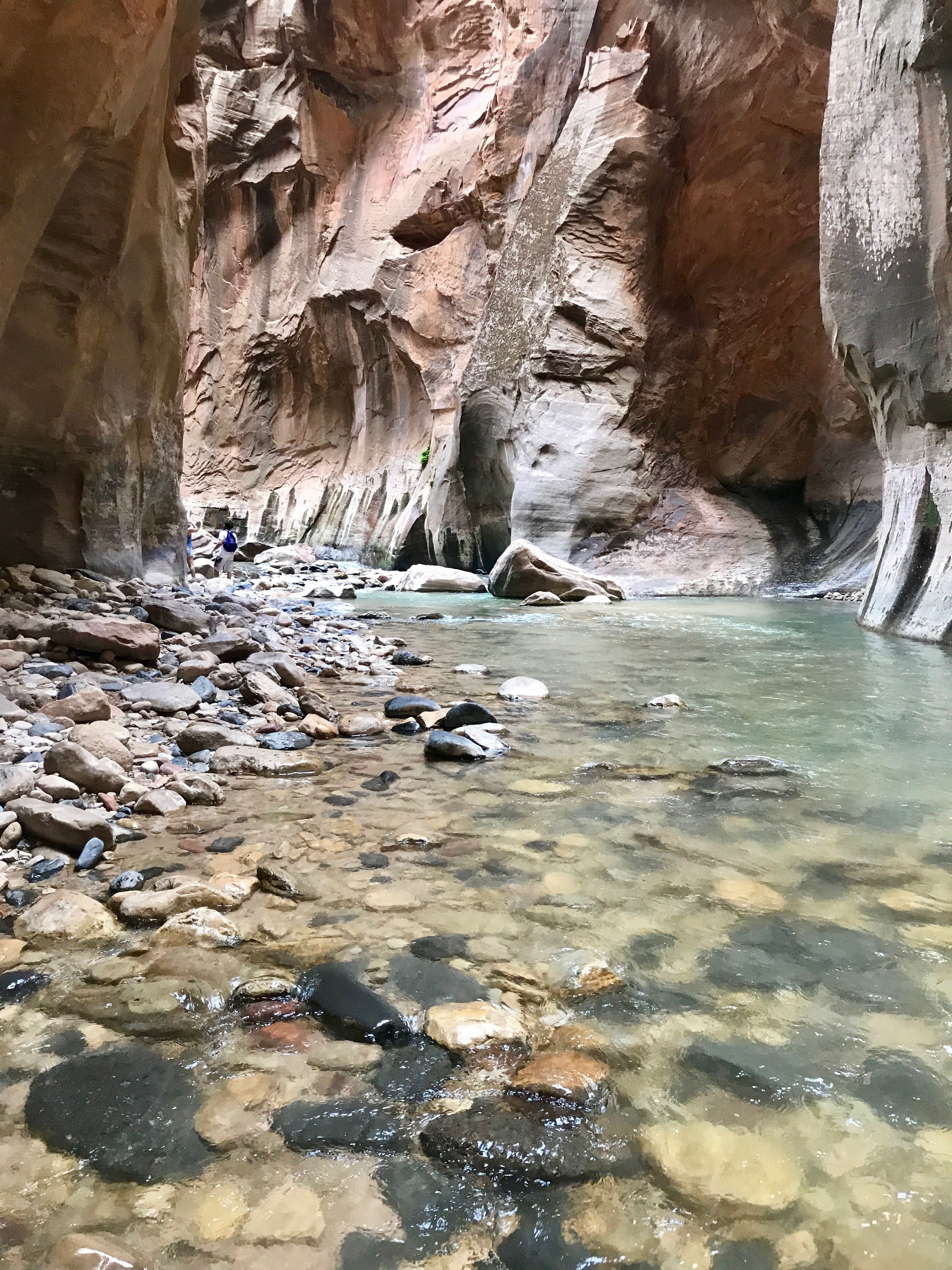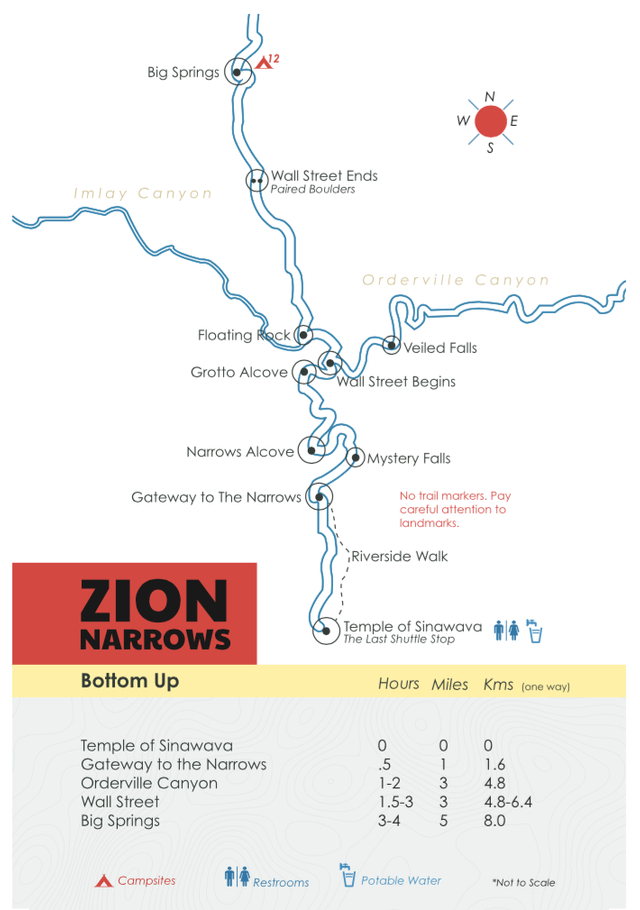"DO NOT HIKE THE NARROWS"
Zion National Park

Sweat dripped from my lower back as my friends and I waited in the 100+ degree weather for the bus shuttle at the visitor center in Zion National Park. A worker who was directing people onto the buses shouted several times, "Do not hike the Narrows! There is a storm, there is a very high potential of flash floods!" I poked my friends with my walking stick (we all had one, that and Canyoneer shoes and neoprene socks we had rented from Zion Guru) to my relief, they all had the same determined look to hike on as I feel I portrayed.
I would like to point out that my friends and I did not completely disregard the workers warning, we had been anticipating this hike for weeks and we were aware of the 20% chance of rain that day. Hiking the narrows during rainfall can be very dangerous as the risk of flash floods increase drastically. Hiking the Narrows involves walking in the Virgin River between 1,500 ft canyon walls, so storms even miles away can cause floods of water over 12 ft high to rush down between the canyon walls. We knew the warning signs and decided to hike on as long as we all felt safe.
We rode the bus shuttle to the last stop, Temple of Sinawava, where the Riverside Walk follows the Virgin River for over a mile before hikers continued on at Gateway to The Narrows. The landmark we wanted to reach was Floating Rock, but if any flash flood warning signs (such as changes in water clarity, floating debris, build up of clouds, or sounds of thunder) emerged, we would turn around. The Narrows was still crowded despite the worker's warning, enclosed not only by the canyon walls but by people as well for the first half mile before the crowds of tourists started to thin into hikers.

The first thing I recall thinking was that the water was not as cold as I had expected it to be (as I reflect back I believe the neoprene socks helped with this), but still refreshing none the less. Water levels vary throughout the year "but hikers can expect water depths up to chest deep less than 5% of the time, knee deep or less 45% of the time, and the remaining 50% hiking on adjacent river banks" Guru. When groups took to the adjacent river banks, I preferred walking, wading, and swimming in the river.

The water stayed very clear throughout our entire hike upstream, reducing our fear of a flash flood, and allowing rocks in the riverbed to be more easily spotted to stack.

One of the hardest parts of this hike was keeping my head down. You have to watch where you step as its easy to slip on the rocks in the moving water, but all I wanted to do was look up at the beautiful canyon walls.

We stopped a few times for snack breaks and a group swim. Make sure if/when you trek through the narrows to bring plenty of water and snacks. I would also like to point out that renting water gear is an option that I strongly suggest, the heavy duty shoes protected our toes as well as provided ankle support and the socks kept our feet warm the entire trip. A little over two hours after beginning at the Riverside Walk, we came across Floating Rock, the destination we wanted to reach for our day hike.
This picture of my friends and I standing on Floating Rock, doesn't capture the entire height of the canyon walls but it does help provide a sense of depth. Right as we were down climbing this landmark, we heard thunder, and so began our trip back to the Temple of Sinawava. Hiking downstream was easier allowing us to move faster as more cracks of thunder could be heard in the distance. At one point a few sprinkles rained down, but it let up quick; there was no change in the water clarity or floating debris as we continued our journey downstream.
The Riverside Walk seemed twice as long heading back than it did heading in, due to our wet clothing and hungry stomachs. Some chafing, a few tired ankles, and a minor sunburn was endured by my group, but in all it was an awesome experience! No permit is needed for day hiking as we did, we hiked about 6 miles round trip. A permit and shuttle are required if you plan to hike the entire 17 miles in one day. There are also 12 campsites in the canyon which require reservations as well as a permit. After hiking The Narrows myself, I now plan to one day camp in those canyon walls. The Narrows is a one of a kind hiking trip up the Virgin River through immensely tall canyon walls that I strongly recommend and can't wait to do it again.
Share your favorite hikes and adventures with me below!


Very misleading title haha I was gripped the whole time anticipating the torrential downpour, seemingly anthropomorphic raging river that was sure to sneak up on you, and your miraculous escape from death's close encounter. Nevertheless, it was well written and the pictures were fun to look at. I'm glad you're not dead. Avidazen
Haha I'm glad I am alive as well. Sorry the title was a little misleading, but it did grab your attention
so awesome!!
Thank you!
Nice post! Would like to visit that place, now :). Upvoted
Thank you, and I hope you do get the chance to go!
It reminded my of hiking of the 'Samaria gorge' in Crete.
Except that your dress-wear for this one is way cooler than anything I remember seeing then! (but I guess that's really what you need when the canyon is flooded :) )
Very well written and beautiful pictures, thank you for sharing your adventure, we don't have canyons like that in Indiana!
Glad you enjoyed the read and I was able to share a bit of the SW coast with you!
gorgeous location and pictures Bailey! I probably would have walked it too despite the 20% chance of rainfall and moderate water levels. Good call, looks like it was worth it.
It was such a cool experience! Definitely worth the risk. Thanks for reading!